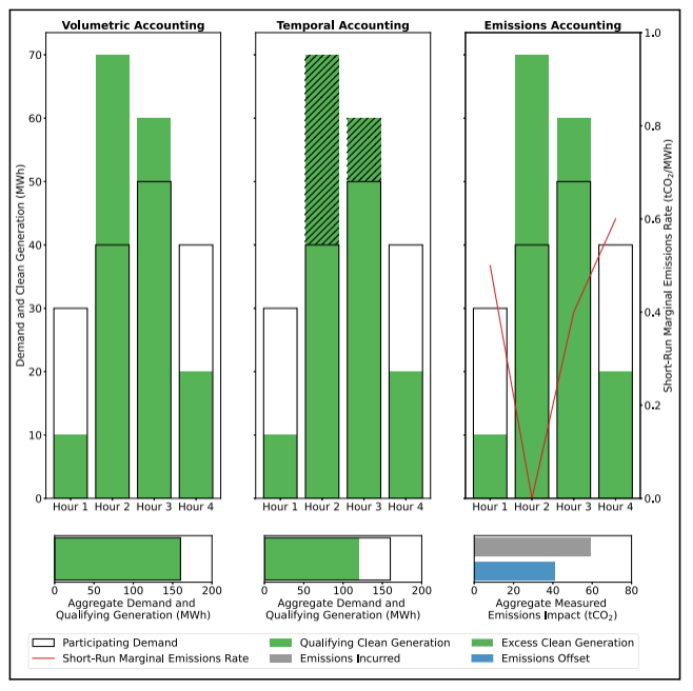Xu Qingyu, a postdoctoral researcher in the Department of Electrical Engineering and Applied Electronics at Tsinghua University and the Energy Governance Research Center of the Energy Internet Innovation Research Institute, published a research paper titled “System-Level Impacts of Voluntary Carbon -free Electricity Procurement Strategies” in the journal Joule. The paper explores the effects of widespread adoption of different “voluntary carbon-free electricity procurement strategies” by organizational institutions (enterprises, governments, universities) on carbon emissions, costs, and installed generation capacity of the entire power system.

Cover of the paper
Organizational institutions often use voluntary carbon-free electricity procurement (often referring to green electricity and green certificate consumption in China) to attempt to reduce their carbon footprint and claim to achieve “zero emissions from electricity consumption.” However, “claiming zero emissions” does not necessarily mean actual emission reductions. In fact, there are various definitions of zero emissions from electricity consumption internationally, along with corresponding voluntary carbon-free electricity procurement strategies. This paper delves into and examines three internationally discussed procurement strategies that can achieve so-called “zero carbon emissions from electricity”:
Strategy One — Total Match: The total amount of carbon-free electricity/certificates purchased by each organization (or the total generation corresponding to the power purchase agreement) ≥ total electricity consumption.
Strategy Two — Time-Matched: The carbon-free electricity/certificates purchased by each organization are matched at a finer time granularity (such as hourly level) to ensure that the carbon-free electricity/certificates matched over time ≥ total electricity consumption.
Strategy Three — Marginal Emission Factor Match: Each organization calculates the carbon emission reduction benefit by multiplying the carbon-free electricity/certificates by the marginal emission factor, while ensuring that the carbon emission reduction benefit is greater than its own electricity carbon footprint, completing carbon offsetting.

Three accounting methods for voluntary carbon-free electricity procurement and their corresponding strategy diagrams: Total Matching (left), Time-of-Use Matching (middle), Marginal Carbon Emission Factor Matching (also known as Carbon Matching, right)
The paper is based on an open-source electricity system planning model and market simulation software GenX, studying and evaluating the impact of voluntary carbon-free electricity procurement by industrial and commercial users in the western United States on the power system. The results show: First, the annual total matching carbon-free electricity procurement strategy has almost no carbon emission reduction benefits; Second, the strategy based on short-term marginal emission factors also has limited effectiveness; Third, purchasing matching by hour can significantly reduce carbon emissions at the system level, but this strategy is costly; Fourth, purchasing matching by hour can increase the market share of flexible and reliable clean generation technologies and long-duration energy storage technologies. In addition, the government’s increase in mandatory clean power standards (similar to renewable energy consumption rights mechanisms in China) can also improve the economic efficiency of all voluntary carbon-free electricity procurement.
Although the results and discussions are based on U.S. data, with the increase in international requirements for disclosing carbon emissions from Chinese products (such as the Carbon Border Adjustment Mechanism (CBAM) in Europe and the new Battery Regulation), Chinese companies urgently need a set of mechanisms for carbon perception of electricity use and carbon reduction of green electricity (certificates). Therefore, the methodology and results of this paper also have certain enlightening significance for China to carry out relevant analysis and mechanism design. The answer to which green electricity procurement strategy (or mechanism requirements) is suitable for large electricity consumers in China, especially export product industries, achieving actual emission reductions and gaining international recognition without significantly increasing product costs, is a question that urgently requires relevant research.
The first co-corresponding author (first in rank) of the paper is Xu Qingyu, a postdoctoral researcher at the Energy Internet Innovation Research Institute of Tsinghua University. The co-first author is Wilson Ricks from Princeton University, and the lead corresponding author is Jesse D. Jenkins from Princeton University.
Joule is the first flagship energy journal under Cell Press, positioned as the sister journal of the well-known journal Cell, with an impact factor of 39.8. Since its establishment, Joule has received widespread attention and recognition from the international academic community and mainly collects high-level research results in the energy-related fields.
Link to the paper:
https://www.cell.com/joule/fulltext/S2542-4351(23)00499-3
Recommended Readings:
Ricks, W., Xu, Q. & Jenkins, J. D. Minimizing emissions from grid-based hydrogen production in the United States [J/OL]. Environ. Res. Lett. 18, 014025, 2023.
DOI: 10.1088/1748-9326/acacb5.
Giovanniello, M.A., Cybulsky, A.N., Schittekatte, T. et al. The influence of additionality and time-matching requirements on the emissions from grid-connected hydrogen production [J/OL]. Nat Energy, 2024.
DOI: 10.1038/s41560-023-01435-0
Zhang Ning, Li Yaowang, Huang Junhui, Li Yaohong, Du Ershun, Li Mingxuan, Liu Yuliang, Kang Chongqing. Carbon Quantification Method and Carbon Meter System [J]. Automation of Electric Power Systems, 2023, Vol. 47 (9): 2-12.
DOI: 10.7500/AEPS20221021001.
Li Yaowang, Liu Yuliang, Yang Xiaobin, et al. Carbon Quantification Method Considering Electricity Trading Information [J/OL]. Proceedings of the Chinese Society for Electrical Engineering, 1-12 [2024-01-17].
DOI: 10.13334/j.0258-8013.pcsee.222323.

















 News & Events
News & Events